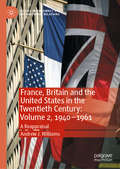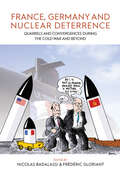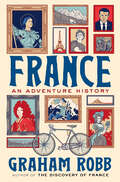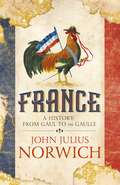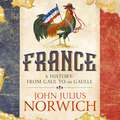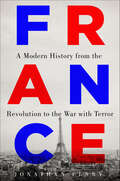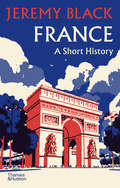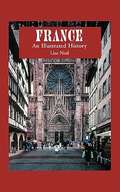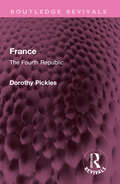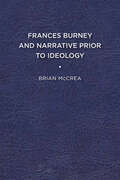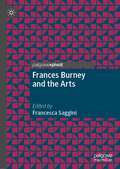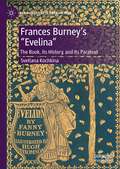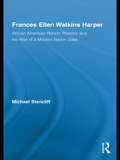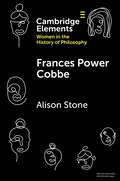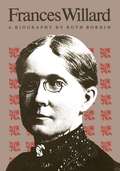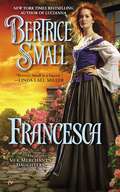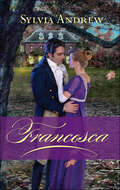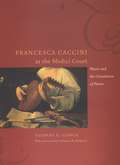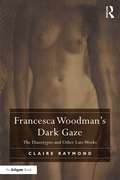- Table View
- List View
France, Britain and the United States in the Twentieth Century: A Reappraisal (Studies in Diplomacy and International Relations)
by Andrew J. Williams"In his account of the relationship between France, the UK and the US Andrew Williams successfully intertwines diplomatic history with international thought. We are presented with a historical stage that includes both the doers and the thinkers of the age, and as a result this is a must read for both diplomatic historians and historians of international thought. The second in a multivolume study, this volume takes the story beyond the fall of France into the war years, the period of post-war reconstruction, and the Cold War. As with the first volume, Williams is an excellent guide, stepping over the ruins of past worlds, and introducing us to an epoch with more than its fair share of both visionaries and villains. Yet in this second volume the stakes are higher, as the United States comes to terms with its role as the paramount world power, Britain faces a world that challenges its imperial order, and France is picking up the pieces from its defeat."Lucian Ashworth, Memorial University, Canada"Following on from his outstanding first volume reviewing the complex interwar relationships between France, Britain and the United States, Williams’ second volume is an indispensable and lucid overview of the vitally important era of post-war reconstruction. From national post-war developments to institutional structures and superpower shifts, Williams examines clearly and engagingly the final passing of pre-modern power structures and the emergence of a new Europe."Amelia Hadfield, University of Surrey, UK"At a time of intense debates about Europe, the ‘Anglosphere’ and empires old and new, Andrew Williams’s book is a timely demonstration that the weight of emotion in the shaping of foreign policy and its makers should not be forgotten. Unearthing some of the ‘forces profondes’ in diplomacy and reflecting on feelings of humiliation and liberation in national constructs, Andrew Williams discusses the cultural conceptions and misconceptions that French, American and British diplomats had of each other, thereby revisiting the reasons why the ‘special relationship’ was largely a myth – but one which had tangible consequences on French and British policies in their retreat from empire. By connecting the personal and the national, the structural and accidental, Williams offers essential insights into the major conflicts of the period and their impact on diplomatic cultures across the Atlantic."Mélanie Torrent, Université Picardie Jules Verne, Amiens, FranceThe second volume of this study of France’s unique contribution to the international relations of the last century covers the period from the Fall of France in 1940 to Charles de Gaulle’s triumphant return to power in the late 1950s. France had gone from being a victorious member of the coalition with Britain and the United States that won the First World War to a defeated nation in a few short weeks. France then experienced the humiliation of collaboration with and occupation by the enemy, followed by resistance and liberation and a slow return to global influence over the next twenty years. This volume examines how these processes played out by concentrating on France’s relations with Britain and the United States, most importantly over questions of post-war order, the integration of Europe and the withdrawal from Empire.
France, Britain, and the Struggle for the Revolutionary Western Mediterranean
by Joshua MeeksThis book investigates the conflict over control over the Western Mediterranean in the late eighteenth-century. The Western Mediterranean during the 1790s featured a constant struggle for control over the region. While most histories point to military events such as the Italian Campaign as descriptive of this struggle between the two competing ideological forces of Revolutionary France and the Counter-Revolutionary First Coalition led by Britain, this book takes a different approach. Rather than looking at the struggle between ideologies, this book looks at the struggle within those ideologies, arguing that the Western Mediterranean states were not simply the battlefields or the prizes of the struggle, but were active participants with goals of autonomy or neutrality. The focus stretches beyond conflict between France and Britain, into the adaptation of ideology for different uses in Tuscany, Toulon, Algiers, Spain, and especially Corsica.
France, Germany, and Nuclear Deterrence: Quarrels and Convergences during the Cold War and Beyond
by Nicolas Badalassi Frédéric GloriantThe legacy of World War II and the division of Eastern and Western Europe produced a radical asymmetry, and a variety of misgivings and misunderstandings, in French and German experiences of the nuclear age. At the same time, however, political actors in both nations continually labored to reconcile their differences and engage in productive strategic dialogue. Grounded in cutting-edge research and freshly discovered archival sources, France, Germany, and Nuclear Deterrence teases out the paradoxical nuclear interactions between France and Germany from 1954 to the present day.
France, Germany, and the Western Alliance (The New Europe: Interdisciplinary Perspectives)
by Philip H Gordon<p>Whether Europe will ever have anything resembling the “common foreign and security policy” described in the Maastricht Treaty will depend most of all on whether France and Germany are able to align their foreign policy goals and means. This thoughtful and original study examines the Franco-German security partnership in its post–Cold War context and analyzes the implications of that partnership for both Europe and the United States. Utilizing French and German sources and extensive interviews in Paris, Bonn, and Washington, Philip Gordon traces the evolution of Franco-German security cooperation since World War II, focusing especially on post-1989 developments. The book's historical and conceptual approach provides a framework for assessing the foundations of the Euro-optimism and -pessimism at odds with each other today. <p>Gordon argues that Franco-German cooperation in the post–Cold War era will be more challenging than it was during a time when the Soviet threat united the two countries in a U.S.-led alliance. The book demonstrates how the end of the Cold War, German unification, a declining U.S. role in Europe, and emerging instabilities to Europe's east and south will test the strength of the Franco-German partnership, and it examines how French and German leaders have stood up to the new challenges so far. Detailed case studies of the Persian Gulf War, the debates over the “Eurocorps,” policies toward Eastern Europe, and the war in Yugoslavia make an invaluable contribution to our understanding of French, German, and Alliance policies in the post–Cold War world. Gordon also identifies new trends in French and German security policies since 1989 and analyzes their effects on the potential for Western and European cohesion.The book concludes that the general commitment in Paris and Berlin to continued cooperation is not in doubt but that a truly common and effective Franco-German or European security policy is unlikely; the national interests of the two countries and their Western partners not only remain different, but they are probably more divergent today than during the Cold War. Consequently, Gordon also argues that U.S. and European fears of Franco-German bilateralism are exaggerated and indeed that the allies have more to gain than to lose from Franco-German cooperation. The problem for the West is not so much that France and Germany have formed a cohesive political-military force within Europe but that they have failed to do so.</p>
France, Mexico and Informal Empire in Latin America, 1820-1867: Equilibrium in the New World (Cambridge Imperial and Post-Colonial Studies Series)
by Edward ShawcrossThis book explores French imperialism in Latin America in the nineteenth century, taking Mexico as a case study. The standard narrative of nineteenth-century imperialism in Latin America is one of US expansion and British informal influence. However, it was France, not Britain, which made the most concerted effort to counter US power through Louis-Napoléon’s military intervention in Mexico, begun in 1862, which created an empire on the North American continent under the Habsburg Archduke Ferdinand Maximilian. Despite its significance to French and Latin American history, this French imperial project is invariably described as an “illusion”, an “adventure” or a “mirage”. This book challenges these conclusions and places the French intervention in Mexico within the context of informal empire. It analyses French and Mexican ideas about monarchy in Latin America; responses to US expansion and the development of anti-Americanism and pan-Latinism; the consolidation of Mexican conservatism; and, finally, the collaboration of some Mexican elites with French imperialism. An important dimension of the relationship between Mexico and France, explored in the book, is the transatlantic and transnational context in which it developed, where competing conceptions of Mexico and France as nations, the role of Europe and the United States in the Americas and the idea of Latin America itself were challenged and debated.
France, Story of a Childhood
by Lara Vergnaud Zahia RahmaniThis moving tale of imprisonment and escape, persecution and loss, is narrated by the daughter of an alleged Harki, an Algerian soldier who fought for the French during the Algerian War for Independence. It was the fate of such men to be twice exiled, first in their homeland after the war, and later in France, where fleeing Harki families sought refuge but instead faced contempt, discrimination, and exclusion. Zahia Rahmani blends reality and imagination in her writing, offering a fictionalized version of her own family's struggle. Lara Vergnaud's beautiful translation from the French perfectly captures the voices and emotions of Rahmani's childhood in a foreign land. While the author delves deeply into the past, she also indicts present-day France and Algeria. From the unique perspective of the daughter of an accused Harki, she examines France's complex and controversial history with its former colony and offers new insight into the French civil riots of 2005. She makes a stirring plea for understanding between generations and cultures, and especially for an end to the destructive practice of condemning children for their fathers' actions and beliefs.
France: A Historical Geography
by Graham RobbA wholly original history of France, filled with a lifetime’s knowledge and passion—by the author of the New York Times bestseller Parisians. Beginning with the Roman army’s first recorded encounter with the Gauls and ending in the era of Emmanuel Macron, France takes readers on an endlessly entertaining journey through French history. Frequently hilarious, always surprising, Graham Robb’s France combines the stylistic versatility of a novelist with the deep understanding of a scholar. Robb’s own adventures and discoveries while living, working, and traveling in France connect this tour through space and time with on-the-ground experience. There are scenes of wars and revolutions from the plains of Provence to the slums and boulevards of Paris. Robb conveys with wit and precision what it felt like to look over the shoulder of a young Louis XIV as he planned the vast garden of Versailles, and the dangerous thrill of having a ringside seat at the French revolution. Some of the protagonists may be familiar, but appear here in a very different light—Caesar, Charlemagne, Louis XIV, Napoleon Bonaparte, General Charles de Gaulle. This extraordinary narrative is the fruit of decades of research and thirty thousand miles on a self-propelled, two-wheeled time machine (a bicycle). Even seasoned Francophiles will wonder if they really know that terra incognita on the edge of Europe that is currently referred to as “France.”
France: A History: from Gaul to de Gaulle
by John Julius Norwich'For his final book, the late Norwich tackled the dauntingly vast subject of two millennia of French history with admirable lightness and urbanity . . . his comic footnotes deserve a review of their own' DAILY TELEGRAPHI can still feel, as if it were yesterday, the excitement of my first Channel crossing (as a child of nearly 7) in September 1936; the regiment of porters, smelling asphyxiatingly of garlic in their blue-green blousons; the raucous sound all around me of spoken French; the immense fields of Normandy strangely devoid of hedges; then the Gare du Nord at twilight, the policemen with their képis and their little snow-white batons; and my first sight of the Eiffel Tower . . . This book is written in the belief that the average English-speaking man or woman has remarkably little knowledge of French history. We may know a bit about Napoleon or Joan of Arc or Louis XIV, but for most of us that's about it. In my own three schools we were taught only about the battles we won: Crécy and Poitiers, Agincourt and Waterloo. The rest was silence. So here is my attempt to fill in the blanks . . .John Julius Norwich's last book is the book he always wanted to write: the extremely colourful story of the country he loves best. From frowning Roman generals and belligerent Gallic chieftains, to Charlemagne (hated by generations of French children taught that he invented schools) through Marie Antoinette and the storming of the Bastille to Vichy, the Resistance and beyond, FRANCE is packed with heroes and villains, adventures and battles, romance and revolution. Full of memorable stories and racy anecdotes, this is the perfect introduction to the country that has inspired the rest of the world to live, dress, eat -- and love better.
France: A History: from Gaul to de Gaulle
by John Julius NorwichA witty history of 2000 years of French history from legendary popular historian John Julius NorwichI can still feel, as if it were yesterday, the excitement of my first Channel crossing (as a child of nearly 7) in September 1936; the regiment of porters, smelling asphyxiatingly of garlic in their blue-green blousons; the raucous sound all around me of spoken French; the immense fields of Normandy strangely devoid of hedges; then the Gare du Nord at twilight, the policemen with their képis and their little snow-white batons; and my first sight of the Eiffel Tower...This book is written in the belief that the average English-speaking man or woman has remarkably little knowledge of French history. We may know a bit about Napoleon or Joan of Arc or Louis XIV, but for most of us that's about it. In my own three schools we were taught only about the battles we won: Crécy and Poitiers, Agincourt and Waterloo. The rest was silence. So here is my attempt to fill in the blanks...John Julius Norwich (at 88) has finally written the book he always wanted to write, the extremely colourful story of the country he loves best. From frowning Roman generals and belligerent Gallic chieftains, to Charlemagne (hated by generations of French children taught that he invented schools) through Marie Antoinette and the storming of the Bastille to Vichy, the Resistance and beyond, FRANCE is packed with heroes and villains, adventures and battles, romance and revolution. Full of memorable stories and racy anecdotes, this is the perfect introduction to the country that has inspired the rest of the world to live, dress, eat -- and love better.(P)2018 Hodder & Stoughton Limited
France: A Modern History from the Revolution to the War with Terror
by Jonathan FenbyWith the defeat of Napoleon Bonaparte at the Battle of Waterloo in June 1815, the next two centuries for France would be tumultuous. Critically acclaimed historian and political commentator Jonathan Fenby provides an expert and riveting journey through this period as he recounts and analyzes the extraordinary sequence of events of this period from the end of the First Revolution through two others, a return of Empire, three catastrophic wars with Germany, periods of stability and hope interspersed with years of uncertainty and high tensions. As her cross-channel neighbor Great Britain would equally suffer, France was to undergo the wrenching loss of colonies in the post-Second World War era as the new modern world we know today took shape. Her attempts to become the leader of the European union was a constant struggle, as was her lack of support for America in the two Gulf Wars of the past twenty years. Alongside this came huge social changes and cultural landmarks, but also fundamental questioning of what this nation, which considers itself exceptional, really stood—and stands—for. That saga and those questions permeate the France of today, now with an implacable enemy to face in the form of Islamic extremism which so bloodily announced itself this year in Paris. Fenby will detail every event, every struggle, and every outcome across this expanse of 200 years. It will prove to be the definitive guide to understanding France.
France: A Short History
by Jeremy BlackA short and entertaining narrative of France from prehistory to the present, recounting the great events and personalities that helped create France’s cultural and political influence today. Country and destination, nation and idea, France has a rich and complex history that fascinates the world and attracts millions of visitors each year to its chateaux and cathedrals, boulevards and vineyards. In this succinct and entertaining volume, historian Jeremy Black narrates how France’s past has created its distinct character and powerful artistic, intellectual, and political influence across the globe. Black takes readers from the cave paintings of Lascaux and the origins of Gothic architecture, to Claude Monet, Edgar Degas, and the Lumiere brothers, and even into the cataclysm of the 1789 revolution, the countercultural student protests of 1968, and the gilets jaunes (yellow vests) today. His account presents a vivid take on history that emphasizes the unexpected nature of events and unpredictable outcomes of a fragmented and crisis-prone nation. In retelling France’s story, Black explores some of its most famous philosophy, literature, art, and architecture—and ties them to the military, political, and cultural shifts that led to their development. With color illustrations, France is a short, easy-to-digest history of a vast subject, and a helpful guide to understanding France today.
France: An Illustrated History
by Lisa NealThis volume outlines French history from prehistoric times to the present. Among the diverse themes discussed are the relations of France with its neighbours, the ever-present tension between national unity and regional autonomy, the role of the Church, and developments in public works and education.
France: The Fourth Republic (Routledge Revivals)
by Dorothy PicklesFirst published in 1955 France: The Fourth Republic is the first book to provide an account of the working constitution of the Fourth French Republic. It summarises the innovations introduced by the 1946 constitution, comments on its working and on the revisions, describes how the French Parliament functions, the organisation of local government, and the new constitutional provisions governing the relations between France and her overseas territories. It also describes the outlook and organisation of the political parties and trade unions. It attempts to capture the institutional background to French politics, post war problems, fundamental characteristics of French political life, permanent attitudes of French politicians, and shifting moods of public opinion. This is an essential read for students and scholars of French politics, political history, European politics, and international relations.
Frances Burney and Narrative Prior to Ideology
by Brian McCreaFrances Burney and Narrative Prior to Ideology works between Burney’s Journals and Letters and her fiction more thoroughly than any study of her in the past twenty-five years. By doing so, it offers significant reinterpretations of Burney’s four novels: Evelina, Cecilia, Camilla, and The Wanderer. It describes Burney’s eluding the major modern–isms through which critics have tried to read her: Feminism (with its “gendering” of beauty and reversal of gender roles); Capitalism and its Marxist critique (here the details of Burney’s housekeeping become important); Professionalism (as a response to status inconsistency and class conflict); and Ian Watt’s “Formal Realism” (Burney perhaps saved the novel from a sharp decline it suffered in the 1770s, even as she tried to distance herself from the genre). Burney’s most successful writing appeared before the coining of “ideology.” But her standing “prior to ideology” is not a matter of chronological accident. Rather, she quietly but forcefully resisted shared explanations—domesticity as model for household management, debt as basis for family finance, professional status as a means to social confidence, the novel as the dominant literary genre—that became popular during her long and eventful life. Frederic Jameson has described Paul de Man, “in private conversation,” claiming, “Marxism . . . has no way of understanding the eighteenth century.” Frances Burney and Narrative Prior to Ideology conjoins Burney’s “eighteenth-centuryness” with her modernity. Published by University of Delaware Press. Distributed worldwide by Rutgers University Press.
Frances Burney and the Arts: Frances Burney And The Theater Arts
by Francesca SagginiThis collection of essays by leading scholars in Burney studies provides an innovative, interdisciplinary critical consideration of the relationship of one of the major authors of the long English Romantic period with the arts. The encounter was not devoid of tensions and indeed often required a degree of wrangling on Burney’s part. This was a revealing and at times contentious dialogue, allowing us to reconstruct in an original and highly focused way the feminine negotiation with such key concepts of the late Enlightenment and Romanticism as virtue, reputation, creativity, originality, artistic expression, and self-construction. While there is now a flourishing body of work on Frances Burney and, more broadly, Romantic women authors, this book concentrates for the first time on the rich artistic and material context that surrounded, supported, and shaped Frances Burney’s oeuvre.
Frances Burney’s “Evelina”: The Book, its History, and its Paratext (New Directions in Book History)
by Svetlana KochkinaEvelina, the first novel by Frances Burney, published in 1778, enjoys lasting popularity among the reading public. Tracing its publication history through 174 editions, adaptations, and reprints, many of them newly discovered and identified, this book demonstrates how the novel’s material embodiment in the form of the printed book has been reshaped by its publishers, recasting its content for new generations of readers. Four main chapters vividly describe how during 240 years, Evelina, a popular novel of manners, metamorphosed without any significant alterations to its text into a Regency “rambling” text, a romantic novel for “lecteurs délicats,” a cheap imprint for circulating libraries, a yellow-back, a book with a certain aesthetic cachet, a Christmas gift-book, finally becoming an integral part of the established literary canon in annotated scholarly editions. This book also focuses on the remodelling and transformation of the paratext in this novel, written by a woman author, by the heavily male-dominated publishing industry. Shorter Entr’acte sections discuss and describe alterations in the forms of Burney’s name and the title of her work, the omission and renaming of her authorial prefaces, and the redeployment of the publisher’s prefatorial apparatus to support particular editions throughout almost two-and-a-half centuries of the novel’s existence. Illustrated with reproductions of covers, frontispieces, and title pages, the book also provides an illuminating insight into the role of Evelina’s visual representation in its history as a marketable commodity, highlighting the existence of editions targeting various segments of the book market: from the upper-middle-class to mass-readership. The first comprehensive and fully updated bibliography of English and translated editions, adaptations, and reprints of Evelina published in 13 languages and scripts appears in an appendix.
Frances Ellen Watkins Harper: African American Reform Rhetoric and the Rise of a Modern Nation State (Studies in American Popular History and Culture)
by Michael StancliffA prominent early feminist, abolitionist, and civil rights advocate, Frances Ellen Watkins Harper wrote and spoke across genres and reform platforms during the turbulent second half of the nineteenth century. Her invention of a new commonplace language of moral character drew on the persuasive and didactic motifs of the previous decades of African-American reform politics, but far exceeded her predecessors in crafting lessons of rhetoric for women. Focusing on the way in which Harper brought her readers a critical training for the rhetorical action of a life commitment to social reform, this book reconsiders her practice as explicitly and primarily a project of teaching. This study also places Harper's work firmly in black-nationalist lineages from which she is routinely excluded, establishes Harper as an architect of a collective African-American identity that constitutes a political and theoretical bridge between early abolitionism and 20th-century civil rights activism, and contributes to the contemporary portrayal of Harper as an important theorist of African-American feminism whose radical egalitarian ethic has lasting relevance for civil rights and human rights workers.
Frances Power Cobbe (Elements on Women in the History of Philosophy)
by Alison StoneThis Element introduces the philosophy of Frances Power Cobbe (1822-1904), a very well-known moral theorist, advocate of animal welfare and women's rights, and critic of Darwinism and atheism in the Victorian era. After locating Cobbe's achievements within nineteenth-century British culture, this Element examines her duty-based moral theory of the 1850s and then her 1860s accounts of duties to animals, women's rights, and the mind and unconscious thought. From the 1870s, in critical response to Darwin's evolutionary ethics, Cobbe put greater moral weight on the emotions, especially sympathy. She now criticised atheism for undermining morality, emphasised women's duties to develop virtues of character, and recommended treating animals with sympathy and compassion. The Element links Cobbe's philosophical arguments to her campaigns for women's rights and against vivisection, brings in critical responses from her contemporaries, explains how she became omitted from the history of philosophy, and shows the lasting importance of her work.
Frances Willard
by Ruth BordinFrances Willard (1839-98), national president of the WCTU, headed the first mass organization of American women, and through the work of this group, women were able to move into public life by 1900. Willard inspired this process by her skillful leadership, her broad social vision, and her traditional womanly virtues. Although a political maverick, she won the support of the white middle class because she did not appear to challenge society's accepted ideals.
Frances and Bernard
by Carlene BauerA &“dazzling and gorgeously written&” novel of art, faith, and life-changing friendship inspired by the correspondence of Flannery O&’Connor and Robert Lowell (Ann Packer). In the summer of 1957, two writers are immersed in their craft at an artist&’s colony nestled in upstate New York when chance brings them together. Frances, a country northerner, as committed to her solitude as she is her faith, and Bernard, a gregarious Bostonian with a propensity towards mania and grand gestures, find themselves forming a friendship, and then a courtship, as they each discover a kindred spirit beneath the obvious differences between them. But, as they become inexorably entwined in each other&’s lives, they struggle with the dependence of their romance and the conflict it causes with their own dreams. Inspired by the lives of Flannery O&’Connor and Robert Lowell, who formed an unlikely connection after meeting at Yaddo in the late fifties, and told in a series of intimate letters between the protagonists, Frances and Bernard is a touching and bittersweet look at what happens when love, desire, hope, faith, and friendship collide. &“Recalling 20th-century masters like Graham Greene and Walker Percy . . . Bauer is herself a distinctive stylist who can write about Simone Weil or Kierkegaard with wit and charm.&” —The New York Times Book Review &“Engrossing . . . Funny, sweet and sad. A lovely surprise.&” —Publishers Weekly, starred review &“A novel of stunning subtlety, grace, and depth . . . compos[ed in] dueling letters of breathtaking wit, seduction, and heartbreak.&” —Booklist, starred review
Francesca
by Bertrice SmallNew York Times bestselling author Bertrice Small continues her glorious historical-romance series featuring four sisters in Renaissance Florence who have anything but marriage on their minds.... Giovanni Pietro d'Angelos selected his oldest daughter's husband, and the marriage proved to be a disaster. He offers to give his next oldest daughter, Francesca, more latitude in choosing a husband than her sister had. But the arrogant beauty has no desire to marry, and she drives every potential suitor away. The Duke of Terreno Boscoso seeks a wife for his heir, Rafaello, and invites Francesca, along with several other possible brides, to come meet him. Francesca's parents think it's a good match, but she refuses to consider it until her father makes her a promise: If he does not suit, you may return. She is therefore shocked when, not long after they meet, Rafaello chooses her as his bride and her parents agree to his proposal--without her consent. Furious and feeling betrayed, Francesca flees into the woods and takes shelter at an inn. There, she earns her keep as a servant--and meets an unlikely suitor who steals her heart. But the future remains uncertain for the runaway bride, who is still promised to another.
Francesca
by Sylvia AndrewFrancesca Shelwood is mortified when Marcus Carne reappears in her life—he stole the most magical, illicit kisses from the young, innocent Francesca! And she swore never to forgive him after being punished for her "wanton" behavior….Now, on her inheritance, Marcus has returned to offer the unimaginable—marriage! An indignant Francesca refuses, but very soon she walks headlong into danger—and the only man ready to sacrifice his life, and reputation, for her sake is Marcus….
Francesca Caccini at the Medici Court
by Catharine R. Stimpson Suzanne G. CusickA contemporary of Shakespeare and Monteverdi, and a colleague of Galileo and Artemisia Gentileschi at the Medici court, Francesca Caccini was a dominant musical figure there for thirty years. Dazzling listeners with the transformative power of her performances and the sparkling wit of the music she composed for more than a dozen court theatricals, Caccini is best remembered today as the first woman to have composed opera. Francesca Caccini at the Medici Court reveals for the first time how this multitalented composer established a fully professional musical career at a time when virtually no other women were able to achieve comparable success. Suzanne G. Cusick argues that Caccini's career depended on the usefulness of her talents to the political agenda of Grand Duchess Christine de Lorraine, Tuscany's de facto regent from 1606 to 1636. Drawing on Classical and feminist theory, Cusick shows how the music Caccini made for the Medici court sustained the culture that enabled Christine's power, thereby also supporting the sexual and political aims of its women. In bringing Caccini's surprising story so vividly to life, Cusick ultimately illuminates how music making functioned in early modern Italy as a significant medium for the circulation of power.
Francesca Caccini at the Medici Court: Music and the Circulation of Power (Women In Culture And Society Ser.)
by Suzanne G. CusickA &“priceless&” study of the life and career of the Renaissance-era Italian who was the first woman to have composed an opera (Gender & History).&“Extraordinary in its breadth, its detail, its insight, and its worth to all participants in early music…. Its contribution is not limited to the musical world, however, as Cusick&’s remarkable command and analysis of her material…has immense value for scholars engaged in cultural studies, performance studies, history, politics, or the study of difference.&”—Renaissance Quarterly A contemporary of Shakespeare and Monteverdi, and a colleague of Galileo and Artemisia Gentileschi at the Medici court, Francesca Caccini was a dominant musical figure there for thirty years. Dazzling listeners with the transformative power of her performances and the sparkling wit of the music she composed for more than a dozen court theatricals, Caccini is best remembered today as the first woman to have composed opera. Francesca Caccini at the Medici Court reveals for the first time how this multitalented composer established a fully professional musical career at a time when virtually no other women were able to achieve comparable success. Suzanne G. Cusick argues that Caccini&’s career depended on the usefulness of her talents to the political agenda of Grand Duchess Christine de Lorraine, Tuscany&’s de facto regent from 1606 to 1636. Drawing on Classical and feminist theory, Cusick shows how the music Caccini made for the Medici court sustained the culture that enabled Christine&’s power, thereby also supporting the sexual and political aims of its women. In bringing Caccini&’s surprising story so vividly to life, Cusick ultimately illuminates how music making functioned in early modern Italy as a significant medium for the circulation of power.
Francesca Woodman's Dark Gaze: The Diazotypes and Other Late Works
by Claire RaymondFocusing on the later work of the American photographer Francesca Woodman (1958-1981), Claire Raymond takes up the question of the disintegrative condition of the art she produced in the last year of her life. Departing from the techniques of her earlier compositions, Woodman worked in the diazotype process for many of these late pieces, most importantly the monumental Blueprint for a Temple. Raymond shows that through her use of diazotype, a medium that breaks down when exposed to light, Woodman created art that is both supremely evocative aesthetically and inherently unstable physically. Woodman, Raymond contends, was imaginatively responding to the end of the durable image, a historical reality acknowledged in the way her work plays the ephemeral and evanescent against the monumental and enduring. Raymond focuses on the theoretical and the curatorial issues surrounding Woodman's diazotypes, a thematic and practical distress that haunts much of her later art, especially the artist's book and photo series Some Disordered Interior Geometries and Portrait of a Reputation. Rather than conceiving of Woodman herself as fragile, an artist chronicling and seeming to yearn for her own disappearance, Raymond juxtaposes Woodman's career-spanning documentation of her own image against other post-war witnesses of trauma - an artist standing in the museum ruins where she emerges most distinctly as a figure of postmodernity.
